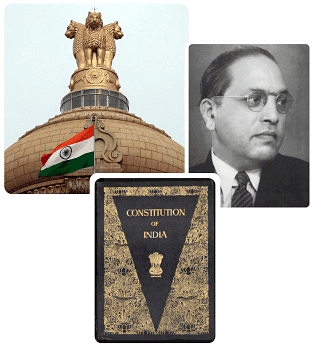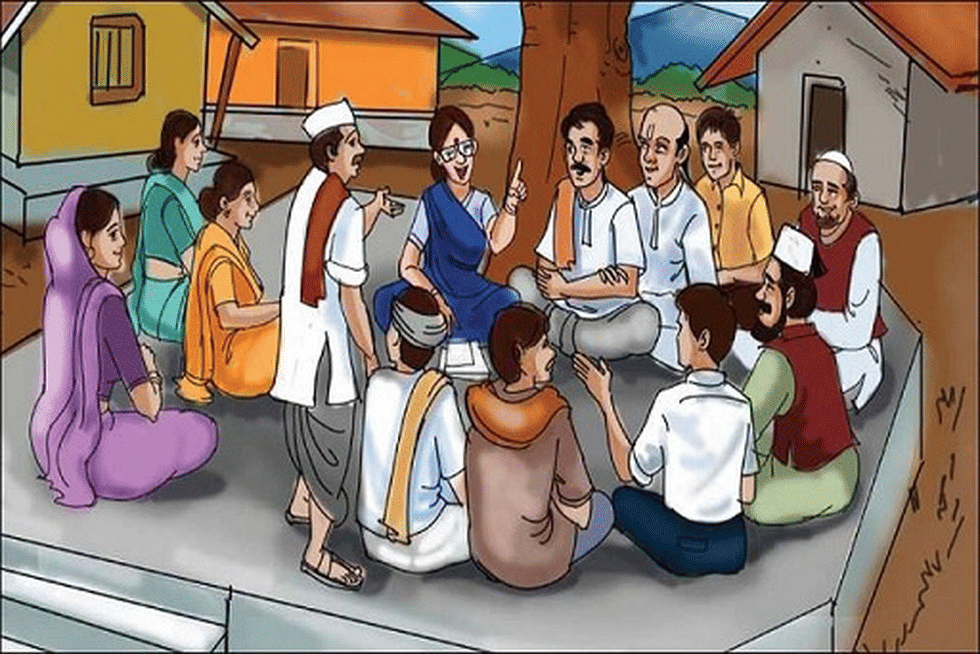The Constitution and Social Change Revision Notes | Sociology Class 12 - Humanities/Arts PDF Download
Constitutional Norms and Social Justice
- Difference between Law and Justice: Law is enforced by the state, whereas justice is based on fairness.
- Role of the Supreme Court: The Supreme Court interprets the Constitution and has expanded the meaning of Fundamental Rights, including the right to life (Article 21) to encompass livelihood, health, shelter, education, and dignity.

Important Interpretations
- Right to Information as part of the Right to Freedom of Speech and Expression (Article 19(1)(a)).
- Equal Pay for Equal Work integrated into the Fundamental Right to Equality (Article 14).
Panchayati Raj and Rural Social Transformation
Ideals of Panchayati Raj
- Panchayati Raj is governance by village-level institutions to promote democracy at the grassroots.
- The 73rd Constitutional Amendment (1992) gave constitutional status to Panchayati Raj Institutions (PRIs).
Key Features of Panchayati Raj
- Three-Tier System: Gram Sabha (village level), Panchayat Samiti (block level), and Zilla Parishad (district level).
- Mandatory Elections: Elections every five years.
- Reservation of Seats: Seats reserved for Scheduled Castes, Scheduled Tribes, and women (33%).
Powers and Responsibilities of Panchayats

- Economic Development: Preparation and implementation of development plans.
- Social Justice: Promotion of schemes enhancing social justice.
- Local Governance: Levying and collecting taxes, maintenance of public amenities, and implementation of government schemes.
Social Welfare and Development Activities
Responsibilities:
- Maintenance of public utilities, family planning promotion, agricultural activities.
- Construction of infrastructure (roads, buildings, schools).
- Monitoring government schemes like IRDP and ICDS.
Income Sources:
- Taxes on property, profession, animals, vehicles, land revenue, and rentals.
- Grants from Zilla Panchayat.
Right to Information: Panchayats must publicly display financial details to ensure transparency.
Nyaya Panchayats
- Functioning: Deal with minor civil and criminal cases, impose fines but cannot award sentences.
- Effectiveness: Successful in mediating disputes and addressing issues like dowry and violence against women.
Panchayati Raj in Tribal Areas
Rich Tradition: Tribal areas have a long history of grassroots democracy.
Meghalaya Example:
- Ethnic Groups: Khasis, Jaintias, and Garos.
- Developed political institutions at village, clan, and state levels.
- Khasis' System: Each clan had a council called 'Durbar Kur,' led by a clan headman.
Exclusion from 73rd Amendment: Many tribal areas are outside its provisions to respect traditional institutions.
Challenges in Tribal Institutions:
- Sociologist Tiplut Nongbri notes they may not be fully democratic.
- Tribal societies have stratification and intolerance towards women.
- Social changes have caused distortions in traditional practices.
Changing Nature of Tradition: Reflects complexities in identifying traditional vs. modern practices.
Democratisation and Inequality
- Challenges: Caste, community, and gender-based inequalities hinder democratic participation.
- Control by Elites: Often, a few wealthy and upper-caste individuals dominate decision-making processes.
Political Parties, Pressure, and Interest Groups

- Role in Democracy: Political parties seek governmental power to pursue specific programs. They represent various social interests.
- Pressure Groups: Organisations that lobby the government for specific interests, such as FICCI, ASSOCHAM, INTUC, and CITU.
- Interest Groups: Pursue specific interests by influencing legislative bodies and may evolve into political movements.
Importance of Political Participation
- Significance: Active participation in Panchayati Raj and other democratic processes is crucial for inclusive governance.
- Empowerment of Women: Reservation of seats for women in local bodies has significantly increased their political participation and decision-making power.
|
62 videos|157 docs|25 tests
|
FAQs on The Constitution and Social Change Revision Notes - Sociology Class 12 - Humanities/Arts
| 1. What are some key constitutional norms that are related to social justice? |  |
| 2. How does Panchayati Raj contribute to rural social transformation? |  |
| 3. What are the powers and responsibilities of Panchayats in India? |  |
| 4. How is Panchayati Raj structured in tribal areas in India? |  |
| 5. How do political parties, pressure groups, and interest groups influence social change in India? |  |
















